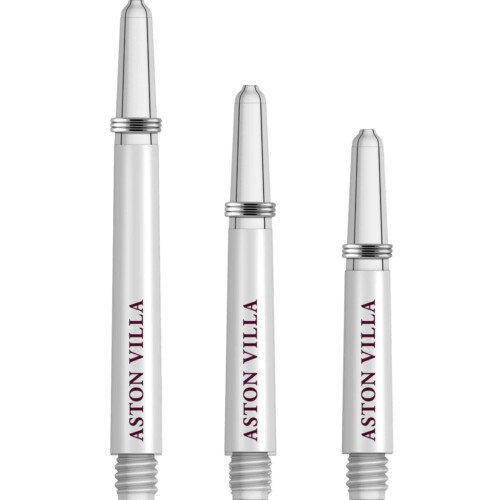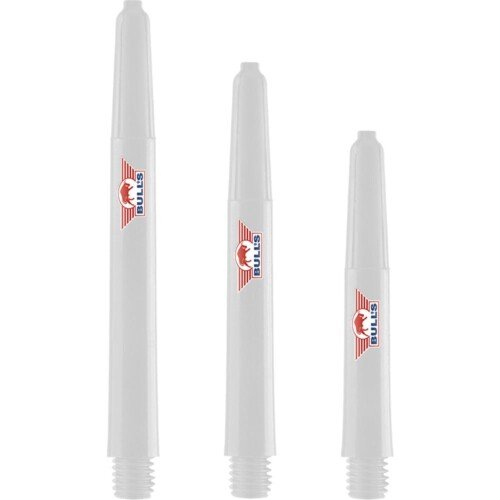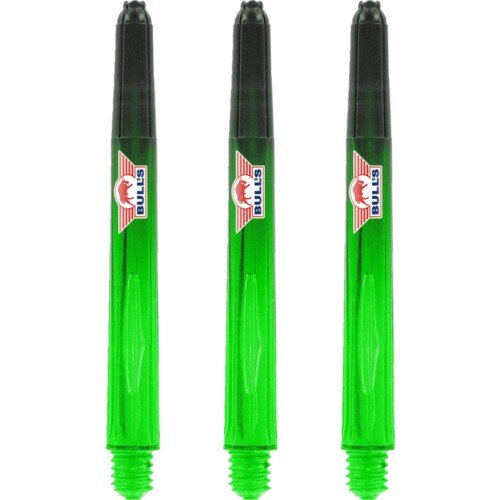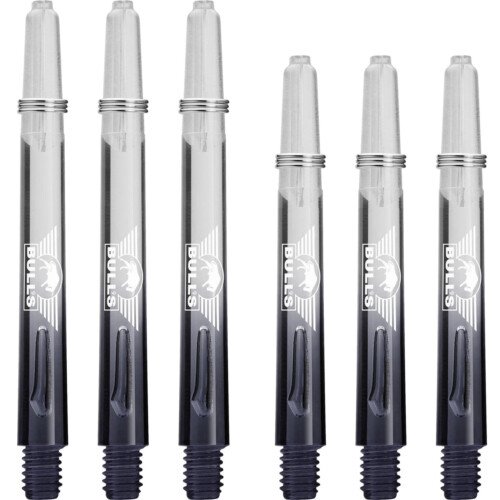The dart shaft, also known as the dart shaft, is the part of the dart that attaches to the shaft and holds the flight in place at the other end. It’s an important item and Darts Corner stocks hundreds of shafts in all kinds of colors and materials, so there’s one to suit every player. Use the filters to narrow down all your options. From micro, short, tweeny and long sizes to plastic and metal materials, we’re sure you’ll find the perfect set of dart shafts to choose from our extensive range. Complete your dart set by purchasing some new dart flights from our wide range. 2 Dart Shafts and Handles
-
- Dart Shafts
*XQMax Max Grip Shafts – Gradient Dart – Red
- $0.90
- XQMax Max Grip Shafts are made from strong polycarbonate with a gradient design, and include springs for added stability. Length: 41mm (excluding 5mm thread). Thread: 2ba.
- Select options This product has multiple variants. The options may be chosen on the product page
-
- Dart Shafts
Aston Villa FC Nylon Shafts – Dart Stems – AVFC – White
- $1.00
- Show your team pride with the Official Aston Villa Football Club Nylon Shafts. These durable and strong dart stems are perfect for fans looking to add a personal touch to their game.
- Select options This product has multiple variants. The options may be chosen on the product page
-
- Dart Shafts
Bolton Wanderers Nylon Shafts – BWFC Football – White
- $1.00
- These officially licensed Bolton Wanderers shafts are crafted from durable nylon. Each pack includes 3 stems with 2ba threading. Show your support in style!
- Select options This product has multiple variants. The options may be chosen on the product page
-
- Dart Shafts
Bulls @501 Shafts – Aluminium Dart Stems – Black
- $3.30
- Experience the @501 advantage with Bulls @501 Black Aluminium Darts Shafts with Twin Ring Grip in Medium. These shafts are designed to enhance your performance with a unique twin ring design that provides superior grip and control.
- Select options This product has multiple variants. The options may be chosen on the product page
-
- Out of Stock
- Dart Shafts
Bulls Airstriper Dart Shafts – Polycarbonate – Black
- Make a statement with your dart setup with Bulls Airstriper Shafts - Black. These visually striking stems feature a sleek black design with a printed Bulls logo, creating a captivating visual effect.
- Read more
-
-
- Dart Shafts
Bulls Airstriper Dart Shafts – Polycarbonate – Clear Black
- $1.20
- Discover the cutting-edge design of Bulls Airstriper Shafts - Clear/Black. These innovative stems showcase a unique two-tone design with a clear base and a black tip, featuring a printed Bulls logo.
- Select options This product has multiple variants. The options may be chosen on the product page
-
- Dart Shafts
Bulls Airstriper Dart Shafts – Polycarbonate – White
- $1.60
- Make a statement with your dart setup with Bulls Airstriper Shafts - White. These visually striking stems feature a sleek white design with a printed Bulls logo, creating a captivating visual effect.
- Select options This product has multiple variants. The options may be chosen on the product page
-
- Dart Shafts
Bulls Airstriper Shafts – Polycarbonate – Clear Green
- $2.10
- Make a statement with your dart setup with Bulls Airstriper Shafts - Clear Green/Black. These visually striking stems feature a unique two-tone design with a clear green base and a black tip.
- Select options This product has multiple variants. The options may be chosen on the product page
-
- Dart Shafts
Bulls Airstriper Shafts – Polycarbonate – Clear Yellow
- $2.10
- Make a statement with your dart setup with Bulls Airstriper Shafts - Clear Yellow/Black. These visually striking stems feature a unique two-tone design with a clear yellow base.
- Select options This product has multiple variants. The options may be chosen on the product page
-
- Dart Shafts
Bulls Side Loader Shafts – Dart Stems – Wing – Black
- $1.45
- The Bulls Sideloader Stems - Medium offer a unique combination of convenience and durability. Crafted from a strong, rubber-like material, these stems are designed to withstand the rigors of regular play.
- Select options This product has multiple variants. The options may be chosen on the product page
-
- Dart Shafts
Bulls X-Ray Shafts – Dart Stems – Gradient – Black
- $1.60
- Crafted for durability, they can handle the impact of repeated throws. The included silver aluminum springs ensure your flights stay securely in place, preventing frustrating pop-outs. Available in Medium length, and also offered in Short lengths and a variety of other eye-catching colors, allowing you to customize your darts to perfectly match your style.
- Select options This product has multiple variants. The options may be chosen on the product page
-
- Dart Shafts
Bulls X-Ray Shafts – Dart Stems – Gradient – Red
- $1.60
- Make a statement with your dart setup with Bulls X-Ray Gradient Stems - Red/Clear. These visually striking stems feature a captivating colour fusion technology, transitioning seamlessly from red to clear.
- Select options This product has multiple variants. The options may be chosen on the product page
Types of Dart Shafts
Dart shafts come in a variety of materials, styles, and lengths. Dart shafts are made from nylon, polycarbonate, and aluminum. Nylon or plastic dart shafts are more common because they are a cheaper option, but they are therefore less durable than other materials and need to be replaced more frequently. Aluminum dart shafts may be more expensive, but they are more durable and less likely to be damaged during play.
The Mission Darts Saber Series is a popular choice that combines the lightness and strength of polycarbonate with the flight grip of an aluminum shaft. Saber Arrow shafts are made from strong polycarbonate, but also have an aluminum core and solid tip for better grip during flight.
Dart shafts come in two types: fixed and rotating. Rotating shafts are usually more expensive than fixed shafts and are for more competitive players. Rotating shafts prevent distractions and prevent the dart from falling off the dartboard by “spinning” when it touches the dart, making way for the next dart to enter the board.
Dart shafts come in a variety of sizes, including mini, extra short, short, tweeny, and medium, and are numbered widely from 1 (shortest) to 8 (longest) in brands such as Cosmo. 5 Does the choice of dart shaft make a difference?
Even if the dart shaft is small, it can affect the entire dart and its trajectory. The size of the dart shaft affects the overall length of the dart, and combined with different shaft shapes, it changes the dart’s trajectory and how it lands on the board.
The material of the dart shaft also affects the dart’s trajectory. For example, dart shafts made of metal are heavier than those made of nylon or polycarbonate. Although it is a small difference, the choice of dart shaft changes the total weight of the dart and can affect how the dart flies through the air.
How to choose the right dart shaft for you
The most important factors when choosing a dart shaft are the length and material. You should also consider where you hold the dart, as the influence of the shaft is related to the center of gravity. If you hold the dart at the front (closer to the tip), you should choose a short shaft, but if you hold the dart at the back of the barrel (closer to the flight), a long shaft is best.
For beginners, most new dart sets come with a set of short dart shaft pieces. This is a good shaft size to start with, as it is somewhere in the middle of the general shaft size chart. For professionals, it depends on the shaft the dart player uses for the tournament. Michael van Gerwen uses a shaft with a nylon ring grip, while Josh Locke opts for a polycarbonate shaft.
If you are a beginner, why not get a dart shaft research pack and try out different shafts to see what works best for you? We have a wide range of dart shafts to choose from, but if you would like something custom made, the Darts Corner has a custom made corner where you can customize various dart items, including custom made shafts. Need help choosing the right dart shaft? Check out our blog on how to choose a shaft for step-by-step instructions. Alternatively, you can get in touch with our customer service team using our contact page and they will be happy to help you with any queries you may have. Darts Corner has a team of experts ready to answer your questions.













